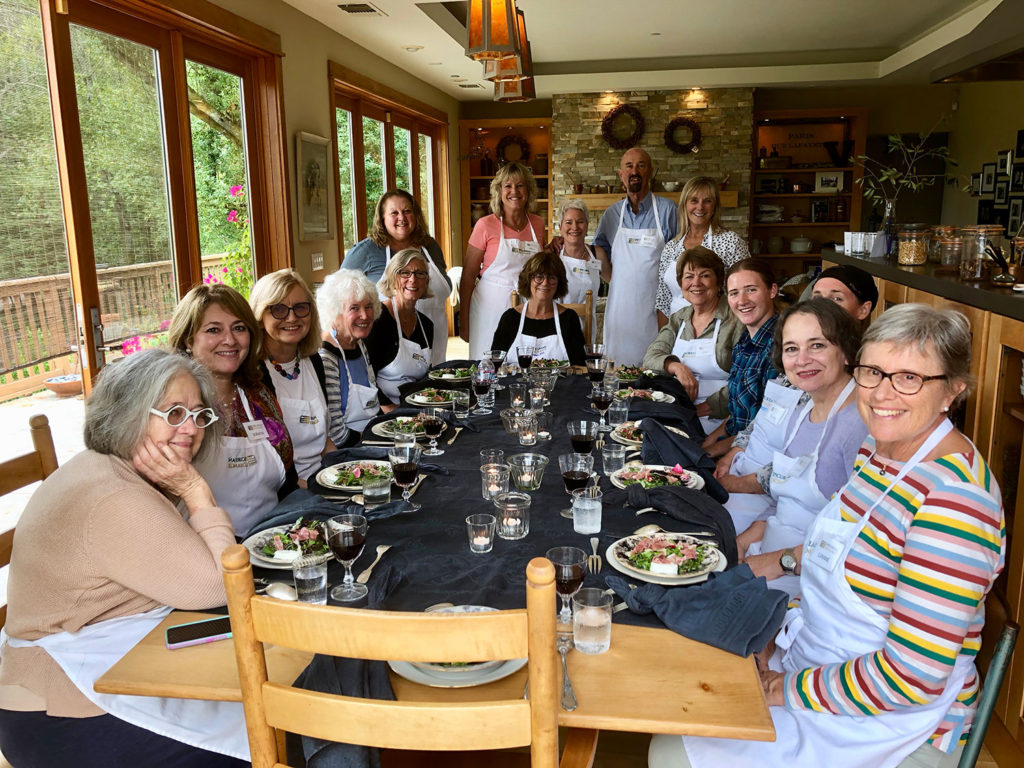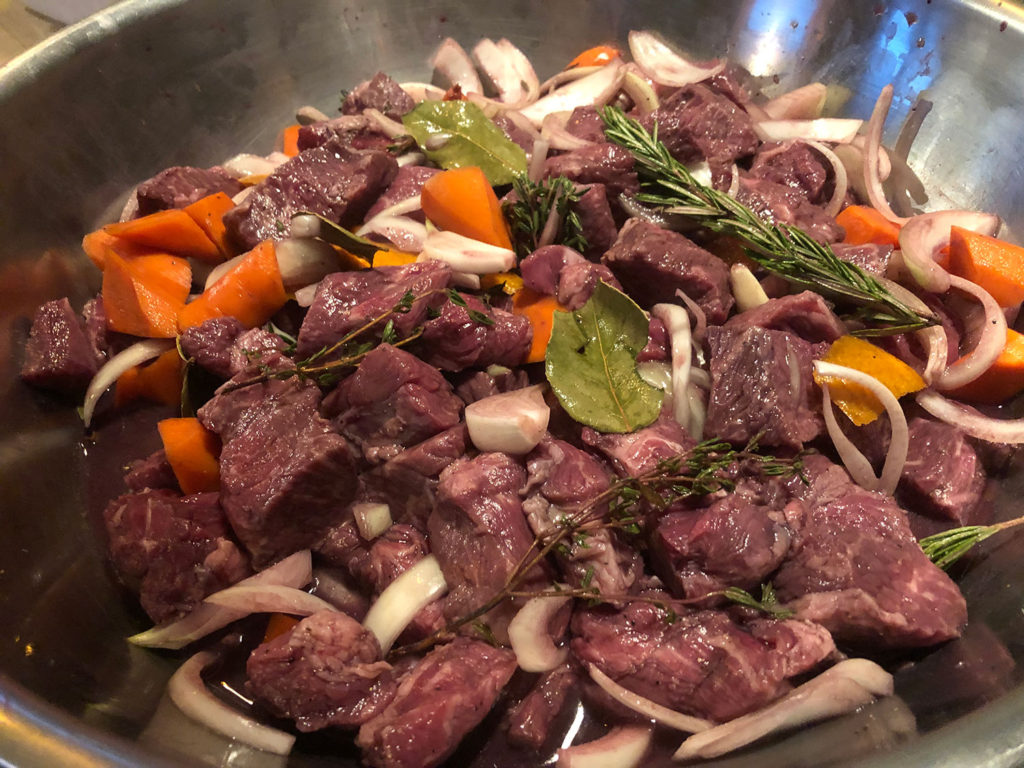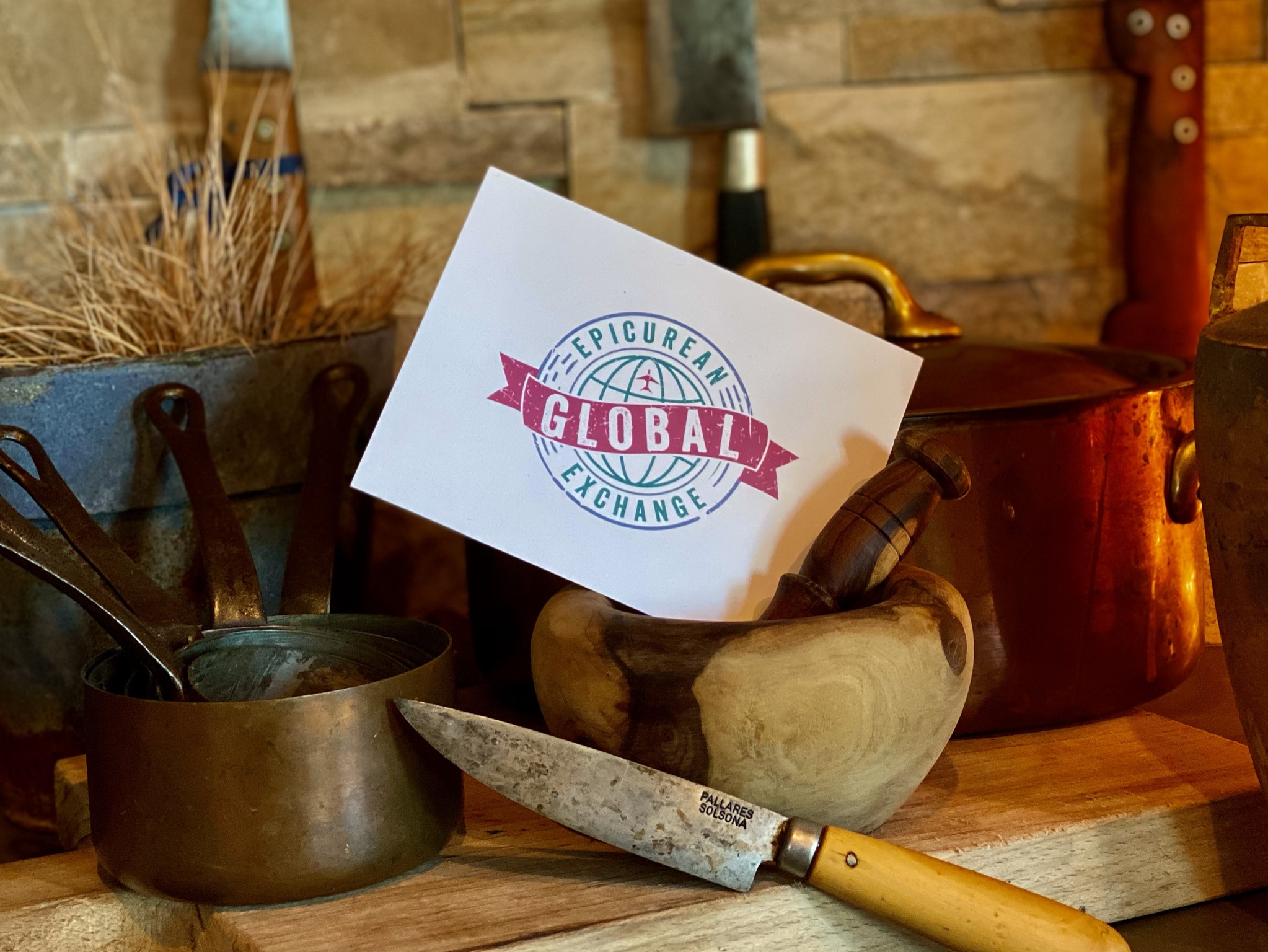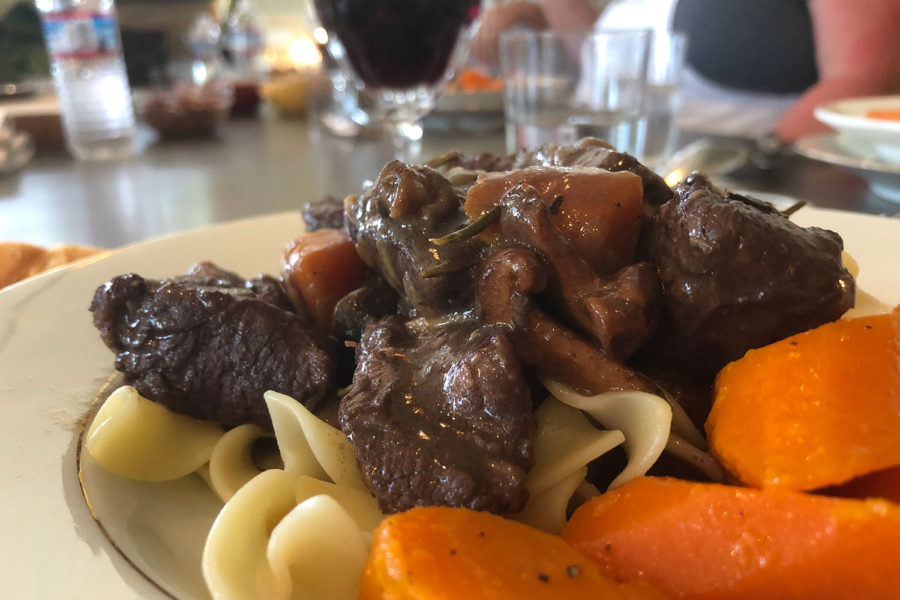Since this week is expected to be wet and wintry, I thought I’d share another classic French braised beef dish. It’s layered with loads of flavor (and cooking steps), but hey, what else is there to do! This recipe is inspired by my friend and mentor, Georgeanne Brennan (in photo, seated at the end in the table in the black sweater), who presented this classic meal at my Orinda cooking school, Epicurean Exchange, in September 2019. I’ve included a photo of the gathering after we have completed the hands-on cooking class and are beginning to enjoy our meal. Really missing the fun, food and community our classes offer, and looking forward to the time we can gather again!

According to French Country Food, “The origin of the word ‘Daube’ probably derives from the Provençal adobar, meaning “prepare, arrange.” This refers to how to cook some meats stewed in a traditional pot-bellied container – made from clay or copper – called a daubière. Each family had its own recipe, handed down from mother to daughter…
“It is to a female flaw, it is said, that we owe this good old recipe for beef stew. The story takes place in Provence, where they never disdained the pleasures of conversation. A peasant woman, one morning, began to cook a piece of beef, and forgets about it immediately, went about verbal exchange with a neighbor who was passing by. Beef slowly began to stick to the bottom of the pot, with a characteristic odor that reminded our cook to her chores. To repair the damage, she covered her roast with water and unrepentant, went back again to her gossip. Three times during the day, she forgets her ox, three times, she watered the sauce. The third time, for fear of criticism from her husband and to conceal the disaster, she used what she had on hand, tomato sauce, herbs and spices. Needless to say, the husband found the food delicious and wanted more. The daube was born!”
Daube de Boeuf
“Slow-simmering and full of rich flavor, the daube – a wine-based stew – is a classic dish that has many variations. Daubes require the less tender cuts of beef that have gelatinous sinews and tendons that thicken and flavor the sauce. A fine, tender cut such as top sirloin will be wasted here, and its daube will be thin and pallid. Instead choose boneless chuck or a combination of boneless chuck and beef shank, which become meltingly tender and flavorful with slow cooking and contribute fully to the sauce’s construction. The traditional accompaniments are pasta and braised carrots, but polenta, gnocchi, or potatoes are also good.” – Georgeanne Brennan
4 pounds boneless beef chuck roast or a combination of boneless chuck and beef shank
2 yellow onions
3 carrots
8 fresh thyme branches, each about 6 inches long
2 bay leaves
1 fresh rosemary branch, about 6 inches long
2 teaspoon salt
2 tablespoons freshly ground black pepper
4 cloves garlic
1 orange zest strip, 4 inches long by ½ inch wide
1 bottle dry red wine such as a Cöte du Rhone, Zinfandel, or Burgundy
1/3 cup pancetta (or bacon), cut into 1/2-inch pieces
2 tablespoons all-purpose flour
1 pound brown Crimini mushrooms, cut into halves or quarters, depending on size
1 ounce dried porcini mushrooms, re-hydrated in 2 cups warm water for 30 minutes; mushrooms removed and liquid reserved
1 pound wide dried pasta noodles
3/4 cup freshly grated Parmesan cheese
1/2 cup chopped fresh flat-leaf parsley
To Prepare the Marinade:
• Cut the beef chuck into 2 – 2 1/2-inch squares. Trim off and discard any large pieces of fat. If using beef shank, cut the meat from the bone in pieces as large as possible. Place the meat in a large enamel, glass, earthenware, or other nonreactive bowl. Quarter 1 of the onions and add the pieces to the meat along with the carrots, thyme, bay leaves, rosemary, 1 teaspoon of the salt, 1 tablespoon of the pepper, 2 cloves of the garlic, and the orange zest. Pour the wine over all the ingredients and turn to mix and immerse the ingredients. Cover and marinate in the refrigerator for at least 4 hours, but preferably overnight.

To Cook the Daube:
• Place the minced pancetta (or bacon) in a heavy-bottomed casserole or Dutch oven large enough to hold the marinating mixture. Place over medium-low heat and cook, stirring occasionally, until the fat is released, about 5 minutes.
• Dice the remaining onion and mince the remaining 2 garlic cloves and add to the pancetta. Sauté over medium heat until translucent, 3 to 5 minutes. Remove with a slotted spoon and set aside.
• Now, drain the meat and reserve the marinade. Pat the meat as dry as possible (important, so it browns properly). Do not be alarmed by its purplish color, as the wine is responsible. Add the meat to the pot a few pieces at a time and sauté for about 5 minutes, turning them once or twice, browning them. Remove the pieces with a slotted spoon and continue until all the meat has been sautéed. When the last of the meat pieces have been removed, add the flour and cook it until it browns, stirring often.
• Raise the heat to high and slowly pour in the reserved marinade and all its ingredients. Deglaze the pan by scraping up any bits clinging to the bottom. Return the sautéed onion, garlic, meat, and any collected juices to the pan. Add the remaining 1 teaspoon salt, the remaining 1 tablespoon black pepper and the 2 cups of the reserved mushroom soaking liquid, and bring to a boil. Reduce the heat to very low, cover with a tight-fitting lid, and simmer until the meat can be cut through with the edge of a spoon and the liquid has thickened, 2 ½ to 3 hours.
• Remove from the heat. Discard the carrots, herb branches, and onion quarters. Skim off some, but not all of the fat.
• Sauté the mushrooms in the remaining olive oil, and salt and pepper to taste. Turn several times; they should be lightly golden. Add the cooked mushrooms, their juices, and the softened porcini mushrooms to the daube.
• Meanwhile, bring a large pot of salted water to a boil. Add the pasta, stir well, and cook according to package directions. Drain.
• Put the pasta in a warmed serving bowl and ladle some of the sauce from the daube over it, adding more salt and pepper if desired, and topping with 1/4 cup of the Parmesan cheese and the parsley. Put the daube in a serving bowl. Pass the remaining cheese at the table.
Serves 6 to 8










